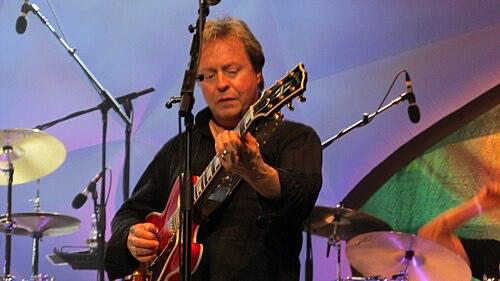In 1965, at just seventeen years old, Rick Derringer (born Richard Zehringer) found himself at the top of the charts with a song that became nothing less than a national sensation. As lead singer of the McCoys, Derringer belted out “Hang On Sloopy” – a garage-rock earworm that hit No. 1 on the Billboard Hot 100 that year . The McCoys were a scrappy band of Midwestern teens, and “Sloopy” was their very first single – a stroke of lightning in a bottle. In fact, the record’s rise was so meteoric it even kept the Beatles’ “Yesterday” stuck at No. 3 that week . The song, with its simple, shout-along chorus, quickly transcended the charts to become an enduring anthem. In Derringer’s home state of Ohio, “Hang On Sloopy” would later be enshrined as the official state rock song , still roared by tens of thousands in unison at Ohio State football games . For a teenager who grew up in small-town Ohio playing Beatles covers in his family’s garage, it was a surreal baptism into rock stardom.
Yet the white-hot burst of “Sloopy” was only the beginning – and it almost ended just as quickly. The McCoys scored a few more hits (notably covers like “Fever” and “Come On, Let’s Go”) , but as the 1960s turned to psychedelia, the band couldn’t sustain their early momentum. By 1969 the McCoys had disbanded (after seven songs in the national Top 100), and the young man who’d belted out one of the ’60s’ biggest sing-alongs was left holding his guitar, wondering what came next . Derringer, however, was anything but a one-hit wonder – he was a guitarist with a destiny. He soon found a new home in the blues-rock scene, joining forces with legendary wildman Johnny Winter and his brother Edgar Winter. Barely out of his teens, Derringer plunged headlong into a tougher, heavier brand of rock. With Johnny Winter, he toured and recorded, and with Edgar he did even more – playing on and producing Edgar Winter’s breakout 1973 hits “Frankenstein” and “Free Ride” . Those songs – one an otherworldly instrumental, the other a feel-good radio jam – showed that Derringer had already evolved from teen idol to bona fide musician’s musician, working behind the scenes to craft classics.
Rock and Roll, Hoochie Koo – Guitar Hero of the ’70s
By the early 1970s, Rick Derringer had built a reputation as a crack guitarist and studio ace, but he wasn’t done claiming the spotlight for himself. In 1973 he stepped forward with a track that would become his signature calling card: “Rock and Roll, Hoochie Koo.” A blistering, boogie-rock number with an unforgettable riff, the song was Derringer’s declaration that he could command the mic and the fretboard in equal measure. Originally written for a Johnny Winter album, Derringer’s own version of “Hoochie Koo” on his debut solo LP All American Boy became a hit – shooting into the Top 25 on the U.S. charts – and later solidified its place in rock history as a staple of classic rock radio. Decades on, you’ll hear its cowbell and guitar crunch in pop culture whenever a jolt of ’70s rebellion is needed – from the cult film Dazed and Confused to a 2022 episode of Stranger Things, which reintroduced the “Rock and Roll, Hoochie Koo” swagger to a new generation .
On stage in the ’70s, Derringer cut a striking figure – not a towering hippie god like some contemporaries, but a lean, fiery presence with virtuoso chops. He formed a hard rock band bearing his own name (simply Derringer), and cranked out guitar-forward albums that, while not huge sellers, earned him respect among fellow musicians. He became the consummate guitar hero’s guitar hero – the guy you’d spot jamming at an after-party with the likes of Alice Cooper, or trading licks in the studio with Steely Dan. (Indeed, Derringer lent his slide guitar to Steely Dan’s sly 1973 single “Show Biz Kids” and a stinging solo to “Chain Lightning” in 1975 .) He even rubbed elbows with the art-rock elite, hanging out in Andy Warhol’s infamous Factory loft during off hours – a far cry from the teen dances in Ohio where he got his start. Through it all, Derringer’s playing retained that Midwestern workmanlike grit and joy: whether it was a no-frills blues shuffle or a glossy pop ballad, he’d give it his all and make it sing.
From “Eat It” to Hulkamania – 1980s Behind the Scenes
If the 1970s established Derringer as a frontman and guitar slinger, the 1980s cemented his status as one of rock’s great unsung collaborators. In that decade, Derringer seemed to be everywhere – often just out of the spotlight, but crucial to the sound. His guitar became a secret weapon on a startling array of hits. One year he was adding a wailing solo to “Total Eclipse of the Heart,” Jim Steinman’s over-the-top power ballad for Bonnie Tyler ; the next he was laying down slick riffs on “Making Love Out of Nothing at All” for Air Supply – a song where he later revealed his soaring solo was one of his personal favorites . He popped up on albums by Barbra Streisand, Kiss, and Cyndi Lauper, effortlessly adapting his style to each. In fact, Cyndi Lauper trusted him enough to bring him on tour as her lead guitarist for years in the late ’80s , where this veteran of ’70s rock found himself powering the songs of an ’80s pop icon on arena stages.
Derringer’s talents weren’t confined to just guitar. He had a keen ear in the producer’s chair too – a fact proven by one of the decade’s unlikeliest success stories. A young parody artist named “Weird Al” Yankovic enlisted Derringer to produce his debut album in 1983, likely sensing that the rock vet knew how to nail both musicianship and humor . The result? “Eat It,” a riotous Michael Jackson spoof with guitar fireworks intact, became a Grammy-winning hit, as did “Fat,” another Derringer-produced Yankovic single a few years later . In all, Derringer produced six of Weird Al’s albums in the ’80s, helping transform goofy pastiches into crisp, radio-ready tracks – an odd legacy, perhaps, but one that speaks to his versatility. He once said he made music for the people, not the critics, and nowhere is that more evident than in the fact that he poured as much craft into a silly song about junk food as he did into a searing blues solo for a rock legend.
And then there was Hulk Hogan. Yes, even the bombastic world of pro wrestling bore Rick Derringer’s stamp. In 1985, at the request of his friend Cyndi Lauper (who was entwined with the WWF’s “Rock ’n’ Wrestling” craze), Derringer wrote and recorded a fist-pumping anthem called “Real American.” The song – all power chords and patriotic bravado – was originally meant for a wrestling tag team, but soon became Hulk Hogan’s iconic entrance music . Generations of wrestling fans needed only to hear that opening riff to know the Hulkster was about to enter the arena. The track even gained an unexpected second life in politics: in 2011, none other than President Barack Obama walked on stage at the White House Correspondents’ Dinner to the tongue-in-cheek strains of “Real American,” winking at a then-current controversy while Derringer’s power chords blared in the ballroom . It was an ironic moment – the liberal president borrowing a theme song created by a rocker who would later align with conservative causes – but it spoke to the cultural ubiquity of Derringer’s music. By the end of the ’80s, Rick Derringer had quietly become a one-man link between disparate corners of pop culture. From earnest rock anthems to parody hits to wrestling theme songs, his work was everywhere, even if his name wasn’t always front and center.
Legacy: An All-American Music Man
Rick Derringer’s career was nothing if not a wild, winding ride – fitting for a musician who titled his first album All American Boy. In later years, he continued to surprise. In the 1990s, after decades in the rock trenches, Derringer took a turn toward faith, becoming an Evangelical Christian and even proudly calling himself a “Jesus freak” as he began recording faith-based albums with his wife Jenda . It was yet another reinvention, as if the man who had played nearly every style of American music was seeking something more. But even while singing about heaven, he never put down his earthly instrument: Derringer kept on touring and playing live well into the new millennium, embracing his elder statesman status. He joined Ringo Starr’s All-Starr Band for multiple world tours, jamming on Beatles tunes and his own, and even shared a stage with Paul McCartney in 2010 to celebrate Ringo’s 70th birthday . True to form, Derringer was most at home in good company, guitar in hand, bringing people together through song.
In May 2025, Rick Derringer passed away at the age of 77 , having spent virtually his entire life on stage or in the studio. By then, the kid from Ohio had long since become an institution – even if his name was never as universally known as some of the superstars he collaborated with. His legacy lives on in the music that’s still all around us. Every time “Hang On Sloopy” prompts a stadium to spell out O-H-I-O in unison, that’s Derringer’s voice leading the chorus . Every time “Rock and Roll, Hoochie Koo” blasts from a speaker and sets heads nodding and air-guitars wailing, his fiery spirit is in the room. And for every younger listener who discovers a classic song through a movie, a TV show, or even a wrestling meme on YouTube – there’s a good chance they’re hearing a bit of Rick Derringer’s handiwork, perhaps without even knowing it. He was the ultimate all-American music man: a one-hit wonder who turned out to have a thousand hits in him, a guitar hero who didn’t care about glory so much as the groove. As long as people are rocking out – at a stadium, in a bar, or in their bedroom – some part of Rick Derringer’s story keeps on playing, a timeless riff in the great American soundtrack.

